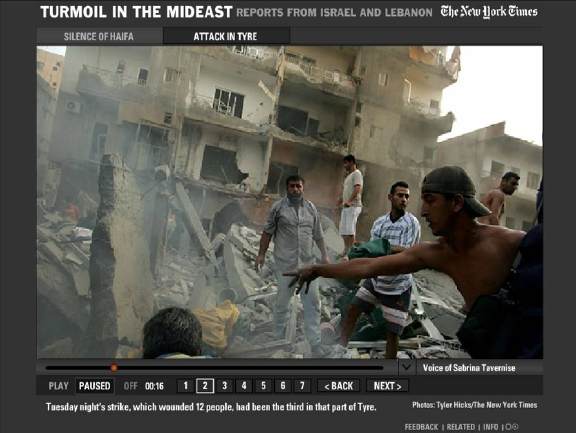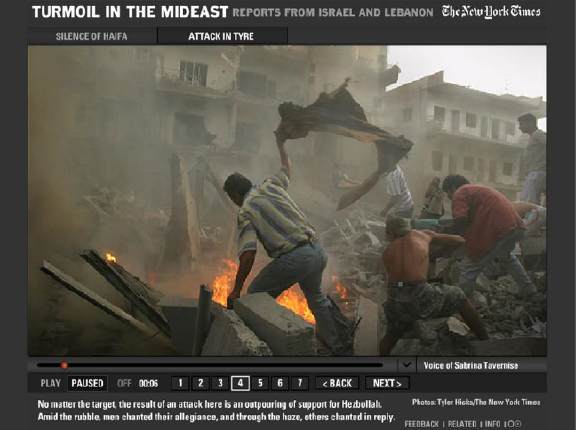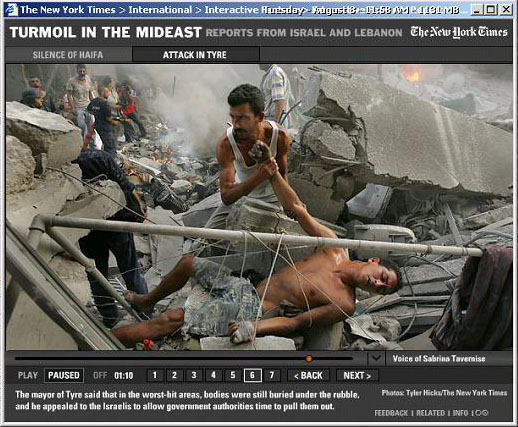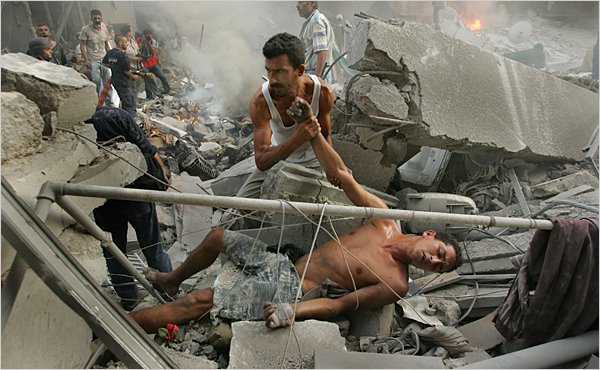Styria
Top-Poster
The New York Times
On August 8, the New York Times entered the fray, with what at first looked like a hoax being featured prominently on its site. Gateway Pundit unveiled the ruse, which likely caused the Times to subsequently issue a correction (see below):

In this first image, one of a series on the N.Y. Times site, a man with a greenish cap (on the right) is seen gesturing at the rubble.

In the second image, you can see the same man at the lower right, wearing the same cap and baggy, washed-out trunks.

And in this final picture, the same man is seen -- easily identifiable by his trunks, his hat pressed under his arm, and his distinctive nose -- seemingly pretending to be dead as someone else tries to lift his "fallen comrade." The Times captioned the image, "The mayor of Tyre said that in the worst hit areas, bodies were still buried under the rubble, and he appealed to the Israelis to allow government authorities time to pull them out. (Photo Tyler Hicks The New York Times)." The unmistakable implication is that the photo depicted what the caption was describing -- a "body" still buried under the rubble. In other words, the guy is now supposed to be dead.

Here's a clearer version of the final picture. If the original caption is to be taken at face value, it's not only obvious that the man is still alive and only feigning death, making the scene a staged hoax, but that Tyler Hicks, the photographer, must have known that he was only acting for the camera, since Hicks had taken the earlier pictures as well.
However, after this was publicized on a variety of blogs, it was discovered (by Michelle Malkin among others) that Tyler Hicks had earlier been interviewed on NPR on July 30, and the same photo was on the NPR site with a different caption, saying that the man "had fallen and was hurt."
The Times then retracted its misleading caption and published a correction that said,
On August 8, the New York Times entered the fray, with what at first looked like a hoax being featured prominently on its site. Gateway Pundit unveiled the ruse, which likely caused the Times to subsequently issue a correction (see below):

In this first image, one of a series on the N.Y. Times site, a man with a greenish cap (on the right) is seen gesturing at the rubble.

In the second image, you can see the same man at the lower right, wearing the same cap and baggy, washed-out trunks.

And in this final picture, the same man is seen -- easily identifiable by his trunks, his hat pressed under his arm, and his distinctive nose -- seemingly pretending to be dead as someone else tries to lift his "fallen comrade." The Times captioned the image, "The mayor of Tyre said that in the worst hit areas, bodies were still buried under the rubble, and he appealed to the Israelis to allow government authorities time to pull them out. (Photo Tyler Hicks The New York Times)." The unmistakable implication is that the photo depicted what the caption was describing -- a "body" still buried under the rubble. In other words, the guy is now supposed to be dead.

Here's a clearer version of the final picture. If the original caption is to be taken at face value, it's not only obvious that the man is still alive and only feigning death, making the scene a staged hoax, but that Tyler Hicks, the photographer, must have known that he was only acting for the camera, since Hicks had taken the earlier pictures as well.
However, after this was publicized on a variety of blogs, it was discovered (by Michelle Malkin among others) that Tyler Hicks had earlier been interviewed on NPR on July 30, and the same photo was on the NPR site with a different caption, saying that the man "had fallen and was hurt."
The Times then retracted its misleading caption and published a correction that said,
